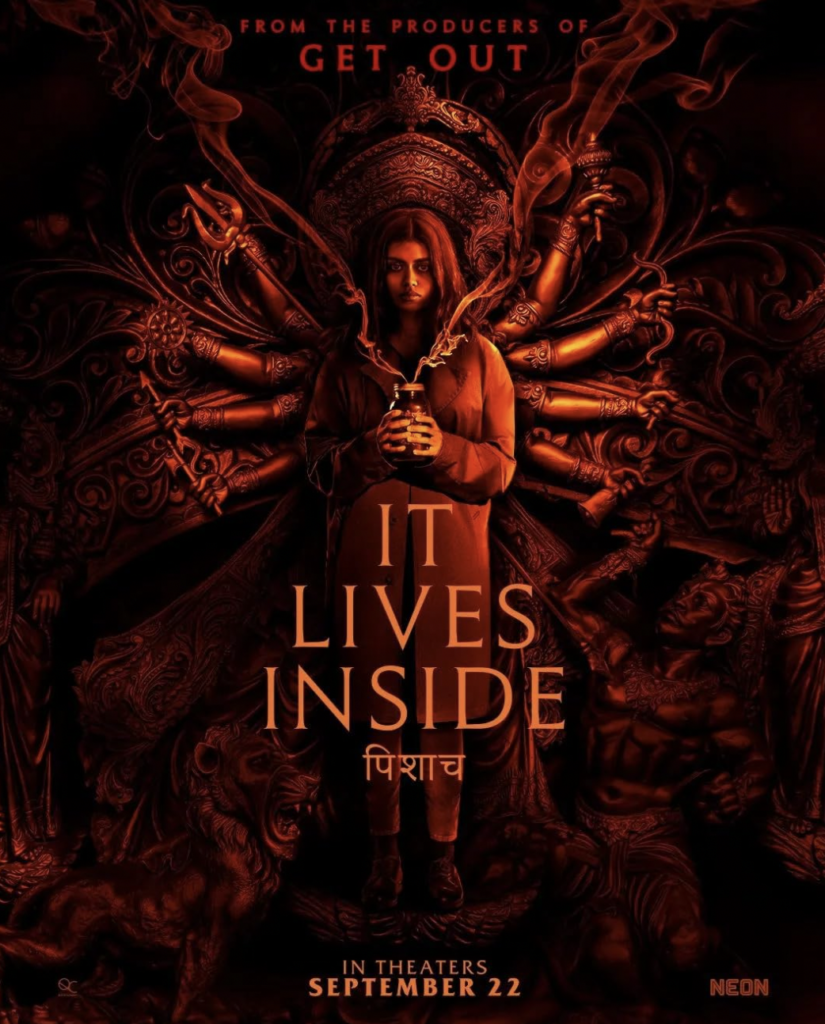
As a second-generation Indian American woman starved for representation in Western media, I jump at any opportunity to watch South Asian stories unfold on the big screen. Thus, I was thrilled when I heard that Indian director Bishal Dutta had created a hot new horror flick with a second-generation Indian-American woman in the starring role.
Released in theaters Sept. 22 — and on Prime Video Oct. 10 — “It Lives Inside” follows Samidha (Megan Suri), also known as Sam, as she navigates the mysterious disappearance of her estranged friend Tamira (Mohana Krishnan) and the supernatural elements that seem to underlie the incident. As Sam comes closer to cracking the case, she grapples with hallucinations, nightmares and indiscriminate attacks on her loved ones before coming face-to-face with the demonic entity at the root of the chaos.
Cinematography is one of the most powerful aspects of “It Lives Inside.” The movie opens with a shot of an attic bathed in blinking, blood-red light just potent enough to relay that something sinister lurks in the shadows. Dutta deftly uses this lighting configuration to indicate the demon’s presence throughout the film.
Close-up shots also compound the tension during intense scenes. When Tamira initially warns Sam of the demon’s existence, Sam rejects her pleas for help, knocking out of Tamira’s hands a smoke-filled jar supposedly containing the demon and leading to Tamira’s disappearance.
Both girls are also subtly shrouded in negative fill — removing light from the shot to increase contrast levels — and smoke when the pull of the demon is especially strong. These elements add to the creepiness and suspense throughout the film, which goes light on the gore but fits comfortably into the horror genre thanks to its psychological grisliness even before the terrifying reveal of the demon’s physical manifestation at its climax.
Regardless, the film definitely has its faults. The plot is muddled by the cultural themes Dutta invokes relating to Sam’s desire to “fit in” with her white peers in a mostly white suburb, which is also the reason for the dissolution of Sam and Tamira’s friendship. The struggle Sam faces between this desire and the pressure to adhere to her Desi culture is not unique to the film but instead feels forced for a number of reasons.
For one, there is little evidence that the town’s Indian population has reason to feel ostracized other than one-off dialogue suggesting so. Sam’s mother asks her father what the family is “still doing here,” referencing supposed scrutiny around Sam’s involvement in the demon–induced death of one of her classmates. It is then mentioned later that the police and presumably the town have written Sam’s peer off as having been killed by an animal, confusing audiences about whether there’s even suspicion surrounding Sam.
There is also a remarkable lack of fanfare around Tamira’s disappearance overall, let alone from the white folks. One then wonders whether Sam’s attempts to distance herself from the “craziness” her people have supposedly come to be associated with involve anything more than self-loathing and vague microaggressions, such as when her white friend asks her to speak Hindi for a Snapchat video.
Sam’s character development by the movie’s conclusion is weak at best. Rather than realize that she can both appreciate her culture and have an average American high school experience, Sam is forced to start taking Hindu customs and rituals more seriously, first to summon the demon with a peace incantation and then to appease the demon by eating raw meat for every meal and devoutly attending her mother’s pujas. It gives Sam’s forlorn gaze into the camera in the film’s final minute an unsavory meaning, as if not just the soul-consuming demon whose spirit Sam has harnessed troubles her but also the fact that she must now conform to a culture she doesn’t fully accept.
Regardless, “It Lives Inside” remains a mostly entertaining watch that keeps the audience hooked for its hundred-minute runtime, with a fast pace and a stellar leading performance by Suri. Though she may not technically have played a “final girl,” à la “Halloween’s” Laurie Strode or “Scream’s” Sidney Prescott, Suri breathes the spunk and determination of horror’s most iconic heroines into Sam. What the movie lacks in writing it tries to compensate for in cinematography and acting, and I appreciate the attempt to incorporate Indian talent and culture into a genre where it’s notably been absent.
I hope that Dutta’s next work is more cognizant of its messaging to paint a more complete picture of the ever-relevant immigrant experience — and produce a better film overall.














